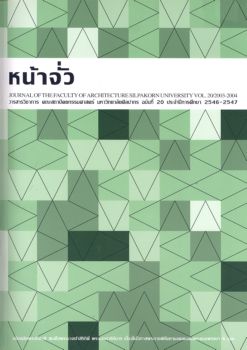The Passage of Time On Architectural Order and Spatial Sequence: Le Camus de Mézières and the Times of the Day Theme
Keywords:
Order, Spatial sequence, TimeAbstract
What is the shaping agent of such architectural organization of space? Does human has complete control over an order of their everyday conduct, and consequently, over the ordering of architectural space? This paper addresses the notion of certain order of time and sequence in everyday activity which leads to an architectural question of ordering space. It explores some parallel between the architectural treatise of Le Camus de Mézières and the Times of the Day theme in seventeenth century Dutch engravings.
If anything can be described by an architectural plan, it might be the nature of human relationship and the sequence of human activities. Elements such as walls, doors, windows and stairs record the traces of such relationship. They are used to divide and re-unite inhabited space. Hidden in the plan is the passage of time. Inhabited spaces are re-united when activities and time merge. In turn, the division of space occurred when different activities inhabited different space at different times. The organization of a plan, the distribution of space, is a portrayal of human figures and their activities at a given place and time. They are the evidence of a way of life and the coupling between everyday conduct and architectural organization. At the heart of is the passage of time.
Attempts of portray the passage of time, with reference to the cyclical change of nature, the various seasons and parts of the day have been made in Western art and literature form antiquity to the present. One such attempt was manifested in the times of the day theme. Cycles of the times of day were a specialty in Dutch engraving of the second half of the sixteenth century. Often, in a series on the times of the day, personifications of deities appear on clouds, floating above sprawling landscapes that includes scenes of diurnal activities. It depicts the change of time in relation to the change of human activities and the cyclical character of nature. In other words, it shows a sequence of everyday life.
This similar question of order and spatial sequence in domestic architecture was undertaken by Le Camus de Mézières in The Genius of Architecture; or the analogy of that art with our sensations. Le Camus's study was a handbook on the planning of the French hotel, the town house of a noble family in which he investigated the proper manner of stirring ideas and emotions through architectural means. His analysis emphasized the importance of order and spatial sequence in the planning of the French hotel. Combined with the cultivation of the picturesque vision, it enabled him to see architecture in a new way.




